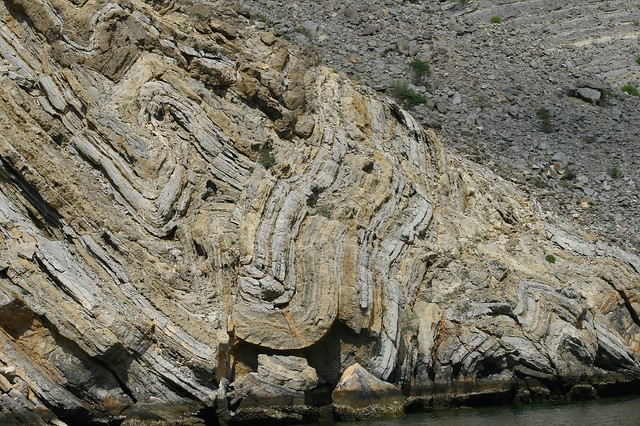 |
| Stone house on the Mountain, Wadi Bih RAK, probably recently constructed. Visible from the main road. |
Evidence of ancient human settlement can still be glimpsed in the remaining cairns and tombstones. According to the Department of Antiquities, the period of human settlement must have been between BC 5000 to BC500. The closest location to see these stone structures is Wadi Bih, a short drive from Ras Al Khaimah heading East towards the UAE-Oman border.
 |
| The view from the ruined stone huts over-looking the graveyard, Wadi bih |
The Building material
 |
Ophiolite Mountain in Bih.
Notice the straight cuts that can be easily used
for construction.
|
 |
| Ophiolite mountain in Musandum, Oman |
Periodic volcanic eruptions and subsequent ash fall-out over the cooling lava forms several sequential layers of deposits. Seismic plate movements have pushed the Hajjar higher and formed these wrinkels in the rock. The layered outcrops have softer shale and soil deposits sandwiched between rock which forms natural straight cuts when cracked open. The stones used in building the cairn and cabins have these natural straight cuts that are of similar thickness.
 |
| General View of the area explored. Wadi Bih |
There seems to be some agreement on the purpose of these structures among the locals who assert that these were constructed as winter homes. I did observe four large rectangular stone huts (approx 2.5m by 2m). All of them had lintels over the doorway to support a roof. Remains of long broken stone (beams?) were seen inside the hut, suggesting a roof collapse.
The smaller Stone Structures
 |
| Another small stone structure approx. 160cm X 90cm |
 |
| Small structure with lintel over the opening. Size approx.120cm X 80cm. |
So it can be safely assumed that the smaller structures were not meant to be graves for the commoner. Perhaps these could be places to worship or abode for the spirits of the recently deceased. I could not find any excavation reports or studies conducted on these small structures, like those conducted on the more popular Hili and Shimal tombs.
